[box type=”bio”] Learning Point of the Article: [/box]
Integrating the available evidence and the clinical expertise of all relevant stakeholders into a shared decision and graduated RTS process after ACL rupture and reconstruction is feasible and successful.
Case Report | Volume 10 | Issue 1 | JOCR January – February 2020 | Page 35-44 | Daniel Niederer, Jan Wilke, Frieder Krause, Winfried Banzer, Tobias Engeroff. DOI: 10.13107/jocr.2020.v10.i01.1628
Authors: Daniel Niederer[1], Jan Wilke[1], Frieder Krause[1], Winfried Banzer[2], Tobias Engeroff[1]
[1]Department of Sports Medicine, Goethe University Frankfurt, Frankfurt am Main, Germany.
[2]Preventive and Sports Medicine, Institute of Occupational, Social and Environmental Medicine, Hospital of the Goethe-University Frankfurt am Main, Germany.
Address of Correspondence:
Dr. Daniel Niederer,
Department of Sports Medicine, Goethe University Frankfurt, Frankfurt am Main, Germany.
E-mail: niederer@sport.uni-frankfurt.de
Abstract
Introduction: Rehabilitation following anterior cruciate ligament (ACL) rupture is often characterized by a large discrepancy between the available scientific evidence and its implementation into practice.
Purpose: We aimed to research, selectively rate, and transfer the available evidence to the returntosport (RTS) process after ACL rupture adopting an athlete time series case study design.
Case Report and Methods: The participant is a male athlete aged 33 who was diagnosed with an isolated right-sided total ACL rupture. Knee arthroscopy using semitendinosus tendon plastic (×4) was performed. For rehabilitation, a graded and shared decision RTS algorithm was derived from the existing evidence and all relevant decision-makers expertise. Starting with basic functional abilities and range of motion, the functional ability at each stage had to be achieved before the next stage was aimed. The corresponding therapeutic focus (in addition to standard therapy) was adopted to reach this goal. Functions to be tested were as follows: Knee function confidence, dynamic balance, isometric and isokinetic strength/torque testing, as well as jumping ability (single-leg hop and triple crossover hop for distance).
Results: RTS was reached (Level 3) 5 months and (Level 2) 10 months post-surgery.
Conclusion: Integrating the available evidence and the clinical expertise of all relevant stakeholders into a shared decision and graduated RTS process after ACL rupture and reconstruction was feasible and successful. Particularly, multiple functional measurements in a time series approach to determine the actual rehabilitation focus seem promising.
Keywords: Return to play, return to sports, functional healing, ligament healing, case report.
Introduction
A rupture of the anterior cruciate ligament (ACL) is a serious hazard for health and career advance in sport. Following ACL reconstruction, affected athletes display high risks of sustaining an ipsilateral rerupture or contralateral subsequent injury, in particular, in the 2 years following the rupture/reconstruction [1, 2]. A considerable risk for the development of osteoarthritis is further given [3]. These severe potential consequences highlight the importance of a rehabilitation process focusing on a safe return to sport (RTS) procedure with a low risk for reruptures and secondary health problems. The RTS after ACL reconstruction is defined as the process of restoring body function and guiding the athlete back to training, sports practice, and competition with a low rerupture risk [4, 5]. Psychosocial readiness as well as functional restoration and ligamentous healing represent the essential criteria for the completion of this process. Most importantly, the decision as to whether RTS is achieved should be undertaken in a shared (inclusion of all relevant stakeholder and guidelines) and stepwise (process-orientated graded RTS) process [4, 5]. Decisions should, thus, be made based on the integration of the available evidence and guidelines, the stakeholders’ clinical experience, and the athletes own preferences [6]. Evidence for both, the graduated shared process [7] and the value of tests for the assessment of functional restoration/healing [8, 9], is available in the biomedical scientific literature. Yet, in semi-professional sports, both are rarely applied in practice [10] and often, one single stakeholder takes the RTS decision. Further, only one single assessment is commonly performed at the hypothetical end of the RTS process [7]. Instead of this highly subjective approach, the performance of multiple measurements, aiming to monitor and verify the course of the RTS process, may be more promising [7]. Conclusively, a large discrepancy between the existing and available evidence and their implementation into practice is observable. Against this background, we aimed to research, selectively rate, and transfer the evidence on the RTS process after ACL rupture, using an athlete timeseries case study design.
The Medical Problem
Patient (case) information
The participant included is a male athlete aged 33 (at the time of ACL rupture). His occupation was (mostly) sedentary. Condition was post-left Achilles tendon total rupture and subsequent reconstruction in May 2016. The cases’ m ain sporting activity was triathlon, on a semi-professional level, until 2015. His maximal oxygen uptake capacity (VO2max) at this time was 68 ml/min/kg of body weight, which can be interpreted as average for elite endurance athletes, or as excellent for the normal population [11]. Running, swimming, and bicycling (the components of triathlon) are all rated as lower level (Level 3) knee stressing [12]. [12]. In addition to his main sport, the case further performed strength training (Level 2-–3), and occasional bouldering and skiing (Level 2). No sporting activities including Level 1 load (pivoting, hard cutting manoeuvreers) were part of the activities performed.
The mechanism of injury was as follows: During skiing on March 3,rd 2017 (15 days prior to before reconstruction, day – -15), the participant experienced a painful right leg flexion with valgus and external rotation and reported subsequent pain, swelling, and knee instability (Lachman positive at first investigation). On March 5,th 2017 (day –-13), descending a flight of stairs, he witnessed right knee flexion with anterior tibia translation including giving way sensation and knee subluxation. Overall, both main ACL rupture mechanisms described in literature occurred [13] and may have jointly or isolated caused the ACL tear.
Clinical findings
The patient was presented to the first orthopaedic specialists’ clinic on March 9,th 2017 (day –-9) and visited a second physician one 1 week later. 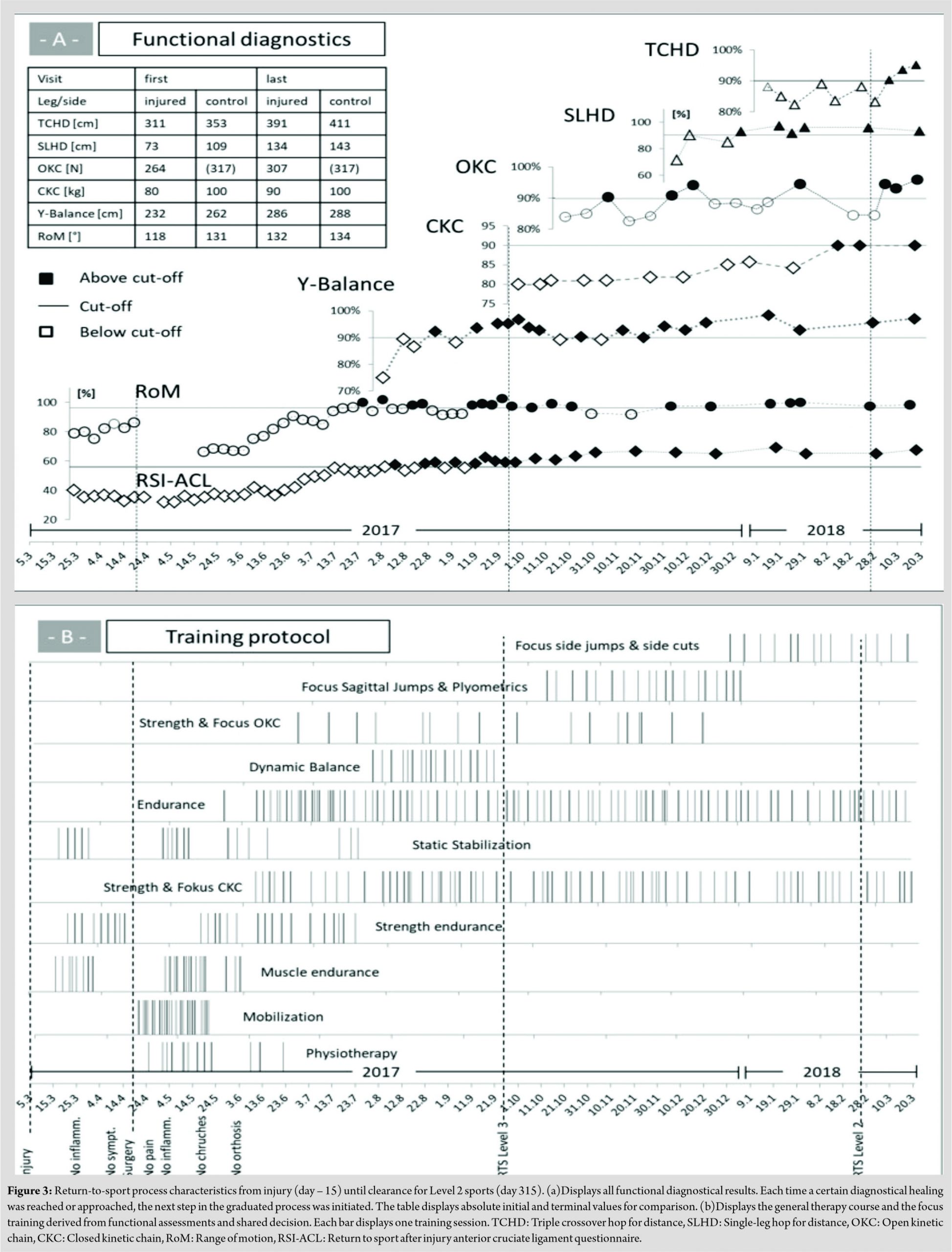
Imaging findings
The therapeutic recommendations, based on clinical examination and imaging (Fig. 1) were as follows: The first specialist found no acute surgery indication and recommended to perform a conservative rehabilitation (6 weeks) using a 90° restricted orthosis. A 7-week-follow-up was scheduled to decide on final conservative/reconstructive therapy. The second opinion (and patient’s decision) was immediate surgical reconstruction and subsequent rehabilitation.
Surgery procedures
Surgery was performed on the April 18,th 2017 (day 0); ICD-code: 5–813.4. The right knee arthroscopy specifics’ were as follows: Resection ACL stump – semitendinosus tendon plastic (×4x) – interference screw ×2x- –dog-bone. Following pre-operative preparation, the surgery procedure and post-operative processings were uncomplicated. The patient was discharged from stationary treatment on April 21,st 2017 (day 3). Outpatient rehabilitation was recommended using standard medication, partial (20 kg) right leg weight weight-bearing, standard post-surgery therapy, and RTS (bicycling after 6 weeks, jogging after 3 months, depending on functional performance all activities after 6 months). Evidence-Based RTS return to sport Process Deduction and Methods
The present study was conducted and written in accordance with the standard recommendations for clinical case reporting [14]. Its objective was to develop and adapt a shared and graduated RTS return to sport process, integrating all relevant decision-makers and the available scientific evidence on functional RTS criteria. For each study included into decision-making, the evidence level (LoE) was rated using the scale provided [15]. Therapeutical focus decisions were taken based on the results of the diagnostical assessment’s values.
Graded RTSReturn to sport process
Adopting a stepwise/graduated RTS process after ACL reconstruction, using repeated/continoustests functional testings for the assessment of functional healing is state-of-the-art according to recent reviews [6, 9] (LoE: 1a). The authors of the reviews highlight that, in the absence of top-level evidence RTS-criteria, the best available evidence should be used. In a recently published narrative review (LoE: 4), Dingenen and Gokeler [7] elegantly highlighted the importance of diagnostic assessments to monitor criterion-based rehabilitation. A gradual and periodized RTS process should, thus, be established after ACL reconstruction [7]. On a consensus expert opinion level, such a graded RTS algorithm exists, both for RTS after general knee injuries [16] (LoE: 5) and after ACL reconstruction [17,18] (LoE: 5). The integration of these guidelines and the cases’ return-to-level-2-sports aim led to the graded RTS process adopted in our case. It is displayed in Figure (Fig. 2). Each time, a certain functional ability (healing) must be reached before the next step can be aimed.
Shared decision-making
Each step of the stepwise RTS process should further be based on shared decision-making [7] (LoE: 4). This RTS decision process completion is recommended to be undertaken including all relevant stakeholder and guidelines [4, 5] (LoE: 2b). Decisions should be made based on the integration of the available evidence and guidelines, the stakeholders’ clinical experience, and the athletes own preferences [6] (LoE: 4). In our case, one expert for graded RTS after ACL rupture using functional tests (DN), two experts on rehabilitation contents and scheduling (JW, and FK), and three physicians to rate ligamentous wound healing (TE, WB, and treating orthopaedic specialist) participated in the shared decision process. Further, the athlete/patient himself was integrated in each step and decision. As the patient is a physician, his expertise in this field was integrated as well during each step. Thus, the patient participated in the decision process two-fold. Beyond the stepwise RTS model used, all relevant guidelines on diagnostic assessments and therapy/rehabilitation were integrated.
Diagnostic assessment
Each functional ability (healing) to be achieved during the RTS process was mirrored by an accurate diagnostic test. Based on the multitude of tests available in literature, tests were selected using the following hierarchical grading: (1). Validity in mirroring the target functional ability,– (2). Prospectively validated predictive value for an ACL-re-rupture, and(3). Sufficient test reliability and objectivity. Top-level evidence, based on prospective cohort studies, for all three requirements was found for subjective knee-strain-related confidence (basic) testing, isokinetic strength testing at 60°, 180°, and 300°/s open kinetic chain (OKC), as well as for hop test symmetry at single-leg hop (jump-landing sagittal plane) and triple crossover hop for distance (side cuts/side jumps) [19, 20] (LoE: 1b) [21, 22] (LoE: 2b). We complemented the test by basic assessments; the subsequently selected tests are characterized in [Table 2]. The eight-repetition maximum (8RM) for CKC assessment was selected due to the lower functional and mechanical stress imposed on the tissue (particularly, in comparison to the one-repetition maximum1RM) and because it can be performed at an earlier stage of the rehabilitation phase. We further decided to measure isometric strength instead of isokinetic torque due to the availability of the respective device at the study conduction site. However, additionally, isokinetic assessments at 60°/sec, 180°/sec, and 300°/sec were performed with a three3-month interval using a dynamometer (Biodex System 3 Pro, Biodex Medical, Shirley, NY, USA). For the measurements, the participant was positioned in an upright seating. The pelvis as well as the thigh of the tested leg were fixed with Velcro straps to minimize secondary movement. The opposite hip was fixed at 90° flexion to limit pelvic and lumbar motion and the knee axis was aligned with the rotational axis of the dynamometer. This here described setup has been shown to be valid [32]. For interpretation and RTS-decision-making at each stage, percentage differences between the affected and the non-affected limb in functional outcomes like such as strength, range of motion (RoM), neuromuscular performance, and jumping performance (limb symmetry indices ([LSI]) are commonly used. Side-to-side deficits of <10% [33](LoE: 4) [19](LoE: 1b) [34](LoE: 1b) or <15% [6](LoE: 4) [8, 9] (LoE: 1a) are recommended. For the present case, an LSI of 10% was selected for all functional outcomes (side symmetry for decision of proceeding to the next step). Recently, estimated preinjury capacity (EPIC) levels instead of LSIs were proposed to be more sensitive in predicting a second ACL injury [20]. They are calculated comparably to the limb symmetry but taking the current value for the injured and a value assessed as quickly as possible after the injury for the unaffected limb into account. As, on the one hand, LSI may overestimate knee function [20], but, on the other hand, performing jumps directly after injury is of high risk in our opinion, we chose to assess EPIC at a 10% level for OKC only. For the other functional outcomes, LSI was kept as an outcome. All diagnostics were aimed to be performed twice a week. Once a functional ability goal (cut-off-value, LSI or EPIC) was reached for the first time and once a shared consensus was reached that the next therapeutic step would be possible, the successive step of healing diagnostics was initiated. If the cut-off for a single outcome was reached in three consecutive measurements, the functional ability was considered as healed and the next step in the graded RTS algorithm was taken. As affected athletes display high risks of sustaining an ipsilateral re-rupture or contralateral subsequent injury, in particular, in the two 2 years following the rupture/reconstruction [1, 2], a two 2-year monitoring for subsequent ACL and other injuries followed.
Therapeutic interventions
Pre-habilitation
Actual approaches in the rehabilitation process increasingly recommend pre-operative rehabilitation. Pre-operative rehabilitation (Prehab) is beneficial to patients with ACL anterior cruciate ligament injury [35] (LoE: 1a-). As Prehab improvements are discussed to be clinically relevant and adverse events occurred only in 3.9% of the patients [36] (LoE: 2b-), it might be of particular relevance after ACL rupture. Low-level evidence (3b) further supports the relevance of Prehab on RTS-rates [35, 37].
Rehabilitation/therapy
Standard rehabilitation strategies were conducted according to Grade A recommendation guidelines [18, 38]. They consisted of:
1. Reduction of inflammation (cooling, inflammation phase, days 0–2/5), followed by
2. Pain reduction and mobiliszation (during proliferation phase at days 2/5) [38, 39] and
3. Functional enhancement training based on standard training [18, 38](LoE: 1a), tissue repair/wound healing stages, and clinical expertise integration. The standard training mostly contained CKC strength training and stabilization/balance exercises. The CKC training [40](LoE: 1a-) was performed gradually, starting from local muscle endurance training without lactate accumulation (31–100 repetitions), strength endurance training (12–30 repetitions), to maximal strength training (8–11 repetitions per set). Each training unit consisted of three sets for all major muscle groups and lasted between 30 and 60 minutes. OKC Open kinetic chain exercise (e.g., knee extension with proximal resistance) was initiated 8-week post-operative, following the same graduated algorithm. Although a recently published systematic review highlights that OKC may be started already at 4 weeks post-operative (at limited RoM) [41], we kept the 8 weeks between surgery and OKC initiation. Stabilization/Balance balance training (local-global; static-dynamic), mobiliszation, and (as addition) endurance training were performed following the standards. Standard training was performed twice a week. The focus training, based on the functional healing derived from the functional tests, was also performed twice a week.
Results
All diagnostics, their processing and the rehabilitation procedures performed, are shown in (Fig. 3). The patient infrequently used electrostimulation and blood flow restriction as further training stimuli. The accompanying isokinetic torque assessment was performed 3 and 6 months post-surgery. Three months post-surgery, quadriceps torque was 168 N for the unimpaired and 80 N for the reconstructed leg (LSI = 48%) at 60°/s, 112 N versus 81 N (72%) at 180°/s, and 84 N versus 63 N (75%) at 300°/s. Six months after reconstruction, torque was 232 N for the uninvolved versus 196 N for the reconstructed (84%) at 60°/s, 163 N versus 156 N (96%) at 180°/s, and 119 N versus 112 N (94%) at 300°/s. There were no recurrence, revision, or reinjury during the follow-up period until May 20,2019 (24 months post-surgery; day 747).
Discussion
We aimed to integrate the evidence and our own clinical expertise into a shared decision and graduated RTS process after ACL rupture and reconstruction in a 33-year-old semi-professional Level 2 and Level 3 athlete. Our multiple measurements and time series approach to identify and adjust the rehabilitation focus was successful and feasible. The athlete successfully returned to sports after 5 months (Level 3) and after 10 months (Level 2). The duration until RTS success in our case is, compared to studies using functional criteria, slightly above average. In contrast, Welling et al. [42] recently found only a low percentage of athletes passing all functional RTS criteria at both 6 and 9 months after ACL reconstruction. Further, our case showed considerable improvements in all functional outcomes measured even after the RTS decision. This is in contrast to a cohort study of Nawasreh et al. [43]: In this study, the authors found that most participants who had not passed the functional LSI cutoffs after 6 months did not pass them 12 and 24 months post-surgery, either. This result is another intriguing hint that our functional healing diagnostic-based rehabilitation was successful. In practice, of course, the frequency of tests implemented in our case may not be feasible in most settings. As our functional tests showed no large inter-measurement differences and all of them are investigated to be reliable, a lower frequency of testing can be considered valid in practice. The tests and rehabilitation itself should further be adapted to the setting, athlete, and type of sport specifics. The number of functional tests applied is, in contrary, not reducible in our opinion, as each of them reflects a specific functional capacity. This has recently been proven on a statistical basis [44]. In their study, the authors aimed to statistically avoid test redundancy. They developed a statistically driven feasible diagnostics battery with the objective to reduce the high quantities of diagnostic tests proposed in literature. Conclusively, one-leg postural control, isokinetic knee extension strength, and hop performance (one-leg hops, side hops) were recommended [44]. Isokinetic measurements continue to represent the gold standard of assessing joint torque/muscle strength. Due to our setting specifics, we were not able to assess dynamic torque at a high frequency. The results of the isokinetic testing in between (all 3 months), however, highlight the validity of the frequently performed isometric OKC assessment as they were, at the time both were measured, not different with respect to the LSI. In training, nevertheless, OKC exercises (both standard and focus) were performed sparse. A reason for this may be found in the low OKC training device availability in most training and rehabilitation centers. Further, CKC focus training was, likewise, performed sparse. The latter was due to the high frequency of CKC exercise in general/standard rehabilitation.
Conclusion
Integrating the available evidence and the clinical expertise of all relevant stakeholders into a shared decision and graduated RTS process after ACL rupture and reconstruction was feasible and successful. Future study is warranted to investigate the effects of the evidence and clinical expertise, integrating shared decision and graduated RTS process adopting a randomized controlled design.
Clinical Message
Integrating the available evidence and the clinical expertise of all relevant stakeholders such as the patient itself, the surgeon, physiotherapists, movement scientist, and exercise therapists into a shared decision and graduated RTS process after ACL rupture and reconstruction is feasible and successful. Especially, performing repetitive functional measurements in a time series approach to determine the actual rehabilitation focus seem promising.
References
1. Waldén M, Hägglund M, Ekstrand J. High risk of new knee injury in elite footballers with previous anterior cruciate ligament injury. Br J Sports Med 2006;40:158-62.
2. Wiggins AJ, Grandhi RK, Schneider DK, Stanfield D, Webster KE, Myer GD. Risk of secondary injury in younger athletes after anterior cruciate ligament reconstruction: A systematic review and meta-analysis. Am J Sports Med 2016;44:1861-76.
3. von Porat A, Roos EM, Roos H. High prevalence of osteoarthritis 14 years after an anterior cruciate ligament tear in male soccer players: A study of radiographic and patient relevant outcomes. Ann Rheum Dis 2004;63:269-73.
4. Shrier I, Safai P, Charland L. Return to play following injury: Whose decision should it be? Br J Sports Med 2014;48:394-401.
5. Shrier I. Strategic Assessment of risk and risk tolerance (StARRT) framework for return-to-play decision-making. Br J Sports Med 2015;49:1311-5.
6. Ardern CL, Bizzini M, Bahr R. It is time for consensus on return to play after injury: Five key questions. Br J Sports Med 2016;50:506-8.
7. Dingenen B, Gokeler A. Optimization of the return-to-sport paradigm after anterior cruciate ligament reconstruction: A critical step back to move forward. Sports Med 2017;47:1487-500.
8. Barber-Westin SD, Noyes FR. Factors used to determine return to unrestricted sports activities after anterior cruciate ligament reconstruction. Arthroscopy 2011;27:1697-705.
9. Barber-Westin SD, Noyes FR. Objective criteria for return to athletics after anterior cruciate ligament reconstruction and subsequent reinjury rates: A systematic review. Phys Sportsmed2011;39:100-10.
10. Niederer D, Wilke J, Vogt L, Banzer W. Return to play after injuries: A survey on the helpfulness of various forms of assistance in the shared decision-making process in semiprofessional athletes in germany. Arch Phys Med Rehabil2018;99:690-8.
11. Zinner C, Sperlich B, Wahl P, Mester J. Classification of selected cardiopulmonary variables of elite athletes of different age, gender, and disciplines during incremental exercise testing. Springerplus2015;4:544.
12. Daniel DM, Stone ML, Dobson BE, Fithian DC, Rossman DJ, Kaufman KR, et al. Fate of the ACL-injured patient. A prospective outcome study. Am J Sports Med 1994;22:632-44.
13. Hayes CW, Brigido MK, Jamadar DA, Propeck T. Mechanism-based pattern approach to classification of complex injuries of the knee depicted at MR imaging. Radiographics 2000;20 Spec No:S121-34.
14. Gagnier JJ, Kienle G, Altman DG, Moher D, Sox H, Riley D, et al. The CARE guidelines: Consensus-based clinical case reporting guideline development. BMJ Case Rep 2013;2013:bcr2013201554.
15. Centre for Evidence-Based Medicine. Levels of Evidence. Oxford: Centre for Evidence-Based Medicine; 2009.Permanent URL: https://www.cebm.net/2009/06/oxford-centre-evidence-based-medicine-levels-evidence-march-2009/.
16. Logerstedt D, Arundale A, Lynch A, Snyder-Mackler L. A conceptual framework for a sports knee injury performance profile (SKIPP) and return to activity criteria (RTAC). Braz J Phys Ther2015;19:340-59.
17. Davies GJ, McCarty E, Provencher M, Manske RC. ACL return to sport guidelines and criteria. Curr Rev Musculoskelet Med 2017;10:307-14.
18. Wilk KE, Arrigo CA. Rehabilitation principles of the anterior cruciate ligament reconstructed knee: Twelve steps for successful progression and return to play. Clin Sports Med 2017;36:189-232.
19. Grindem H, Snyder-Mackler L, Moksnes H, Engebretsen L, Risberg MA. Simple decision rules can reduce reinjury risk by 84% after ACL reconstruction: The Delaware-Oslo ACL cohort study. Br J Sports Med 2016;50:804-8.
20. Wellsandt E, Failla MJ, Snyder-Mackler L. Limb symmetry indexes can overestimate knee function after anterior cruciate ligament injury. J Orthop Sports Phys Ther2017;47:334-8.
21. Kyritsis P, Bahr R, Landreau P, Miladi R, Witvrouw E. Likelihood of ACL graft rupture: Not meeting six clinical discharge criteria before return to sport is associated with a four times greater risk of rupture. Br J Sports Med 2016;50:946-51.
22. Paterno MV, Huang B, Thomas S, Hewett TE, Schmitt LC. Clinical factors that predict a second ACL injury after ACL reconstruction and return to sport: Preliminary development of a clinical decision algorithm. Orthop J Sports Med 2017;5:2325967117745279.
23. Webster KE, Feller JA, Lambros C. Development and preliminary validation of a scale to measure the psychological impact of returning to sport following anterior cruciate ligament reconstruction surgery. Phys Ther Sport 2008;9:9-15.
24. Gagnier JJ, Shen Y, Huang H. Psychometric properties of patient-reported outcome measures for use in patients with anterior cruciate ligament injuries: A systematic review. JBJS Rev 2018;6:e5.
25. Gokeler A, Welling W, Zaffagnini S, Seil R, Padua D. Development of a test battery to enhance safe return to sports after anterior cruciate ligament reconstruction. Knee Surg Sports TraumatolArthrosc2017;25:192-9.
26. Bronner S, Agraharasamakulam S, Ojofeitimi S. Reliability and validity of electrogoniometry measurement of lower extremity movement. J Med Eng Technol 2010;34:232-42.
27. Shaffer SW, Teyhen DS, Lorenson CL, Warren RL, Koreerat CM, Straseske CA, et al. Y-balance test: A reliability study involving multiple raters. Mil Med 2013;178:1264-70.
28. Taylor JD, Fletcher JP. Reliability of the 8-repetition maximum test in men and women. J Sci Med Sport 2012;15:69-73.
29. Herbsleb M, Tutzschke R, Czepa D, Gabrielet HH, Hilberg T. Isometrische maximalkraftmessungen der quadrizepsmuskulatur. Durchführbarkeit und reliabilitätbeipatientenmithämophilie (Maximal isometric strength measures of the quadriceps muscles. Feasibility and reliability in patients with haemophilia). Hamostaseologie 2010;30 Suppl 1:S97-103.
30. Reid A, Birmingham TB, Stratford PW, Alcock GK, Giffin JR. Hop testing provides a reliable and valid outcome measure during rehabilitation after anterior cruciate ligament reconstruction. Phys Ther2007;87:337-49.
31. Noyes FR, Barber SD, Mangine RE. Abnormal lower limb symmetry determined by function hop tests after anterior cruciate ligament rupture. Am J Sports Med 1991;19:513-8.
32. Taylor NA, Sanders RH, Howick EI, Stanley SN. Static and dynamic assessment of the biodex dynamometer. Eur J Appl PhysiolOccupPhysiol1991;62:180-8.
33. Lynch AD, Logerstedt DS, Grindem H, Eitzen I, Hicks GE, Axe MJ, et al. Consensus criteria for defining “successful outcome” after ACL injury and reconstruction: A Delaware-Oslo ACL cohort investigation. Br J Sports Med 2015;49:335-42.
34. Adams D, Logerstedt DS, Hunter-Giordano A, Axe MJ, Snyder-Mackler L. Current concepts for anterior cruciate ligament reconstruction: A criterion-based rehabilitation progression. J Orthop Sports Phys Ther2012;42:601-14.
35. Giesche F, Niederer D, Banzer W, et al. Evidence for the effects of prehabilitation before ACL-reconstruction on return to sport-related and self-reported knee function: a systematic review; in revision 2019.
36. Eitzen I, Moksnes H, Snyder-Mackler L, Risberg MA. A progressive 5-week exercise therapy program leads to significant improvement in knee function early after anterior cruciate ligament injury. J Orthop Sports Phys Ther2010;40:705-21.
37. Failla MJ, Logerstedt DS, Grindem H, Axe MJ, Risberg MA, Engebretsen L, et al.Does extended preoperative rehabilitation influence outcomes 2 years after ACL reconstruction? A comparative effectiveness study between the MOON and Delaware-Oslo ACL cohorts. Am J Sports Med 2016;44:2608-14.
38. van Melick N, van Cingel RE, Brooijmans F, Neeter C, van Tienen T, Hullegie W, et al. Evidence-based clinical practice update: Practice guidelines for anterior cruciate ligament rehabilitation based on a systematic review and multidisciplinary consensus. Br J Sports Med 2016;50:1506-15.
39. Nyland J, Mattocks A, Kibbe S, Kalloub A, Greene JW, Caborn DN, et al. Anterior cruciate ligament reconstruction, rehabilitation, and return to play: 2015 update. Open Access J Sports Med 2016;7:21-32.
40. Kruse LM, Gray B, Wright RW. Rehabilitation after anterior cruciate ligament reconstruction: A systematic review. J Bone Joint Surg Am 2012;94:1737-48.
41. Janssen RP, van Melick N, van Mourik JBA, Reijman M, van Rhijn LW. ACL reconstruction with hamstring tendon autograft and accelerated brace-free rehabilitation: A systematic review of clinical outcomes. BMJ Open Sport Exerc Med 2018;4:e000301.
42. Welling W, Benjaminse A, Seil R, Lemmink K, Zaffagnini S, Gokeler A, et al. Low rates of patients meeting return to sport criteria 9 months after anterior cruciate ligament reconstruction: A prospective longitudinal study. Knee Surg Sports TraumatolArthrosc2018;26:3636-44.
43. Nawasreh Z, Logerstedt D, Cummer K, Axe MJ, Risberg MA, Snyder-Mackler L, et al.Do patients failing return-to-activity criteria at 6 months after anterior cruciate ligament reconstruction continue demonstrating deficits at 2 years? Am J Sports Med 2017;45:1037-48.
44. Schelin L, Tengman E, Ryden P, Häger C. A statistically compiled test battery for feasible evaluation of knee function after rupture of the anterior cruciate ligament derived from long-term follow-up data. PLoS One 2017;12:e0176247.
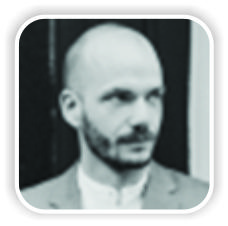 |
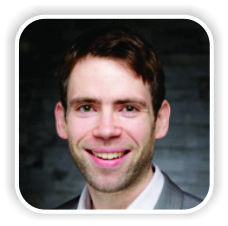 |
 |
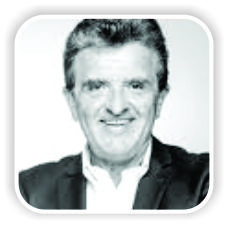 |
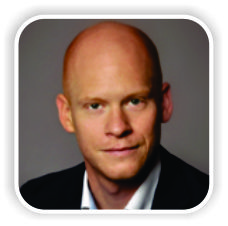 |
| Dr. Daniel Niederer | Dr. Jan Wilke | Dr. Frieder Krause | Dr. Winfried Banzer | Dr. Tobias Engeroff |
| How to Cite This Article: Niederer D, Wilke J, Krause F, Banzer W, Engeroff T. Integrating the Evidence and Clinical Expertise in the Shared Decision and Graduated ReturntoSport Process: A Time Series Case Study after Anterior Cruciate Ligament Rupture and Reconstruction. Journal of Orthopaedic Case Reports 2020 Jan-Feb;10(1): 35-44. |
[Full Text HTML] [Full Text PDF] [XML]
[rate_this_page]
Dear Reader, We are very excited about New Features in JOCR. Please do let us know what you think by Clicking on the Sliding “Feedback Form” button on the <<< left of the page or sending a mail to us at editor.jocr@gmail.com








